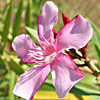Nerium oleander (Oleander) is a common riparian evergreen shrub. It branches into erect branches, commonly reaches a height of 1.5 m, and may even reach a height of 4 m. The branches are elastic. The leaves are opposite or arranged in whorls of 3 or 4. The leaf is glabrous, lanceolate, and is carried on a short petiole. It is 15 cm long, with an entire margin and is leathery to the touch. Its secondary veins are perpendicular to the midvein at an almost right angle, parallel to each other and dense.
All parts of the plant secrete an extremely toxic resin when injured. A powder made of dried Oleander leaves is used to poison pests. Several streams in Israel are called Wadi Dipla or Wadi Dopaila in Arabic, after the Arabic name for Oleander.
Oleander blooms in the summer, from May to August, similarly to many riparian plants that do not suffer from a shortage of water during the warm season. Its roots may grow deep into the bottom of streams that dry up in the summer, and it therefore does not suffer from dryness and thrives and blooms in the summer even in mountainous wadis that preserve humidity in the depth of their bottoms.
The flower is pink, large (4 cm). The bloom is abundant, and colors entire strips of riverside landscapes. The flowers that are shed remain fresh for a long time and spread dense pink carpets over these landscape strips. The flower is twisted around itself while still a bud, as in the entire family and in related families of the order Gentianales. The calyx is green, the corolla is spiked, its tube is long, its lobes are spread apart. The throat of the corolla tube is decorated with a pappose corona, which resembles the petals in texture and color. The stamens are connected in the middle of the corolla tube. The anthers are saggitate at their base, acuminate at their head into a pinnate and twisted pilose bristle.
The fruit is dry, linear, 15 cm long. It is green with a hint of purple. Upon drying it becomes brown and twisted, a crack opens along its length and it releases seeds that are equipped with a light brown pappus which is adapted to dispersion by the wind. It appears that the dispersion is very effective, like many other riparian plants, because the riparian habitat is unstable over the years, and the course of many streams and other water sources dries, or conversely, new courses are created for the stream every few decades.
Oleander grows in all parts of Northern Israel along the banks of ever-flowing streams and along streams that dry up in the summer with a stony bottom, and the riparian plant association is named after it. It reaches peaks of density and height in Nahal Betzet in the Galilee where Oleander shrubs look like real trees with a trunk, and in Nahal Zavitan in the Golan Heights where Oleander shrubs creates a kind of tangled and dense Maqui. It is an enigma why it is so dominant and developed in Nahal Betzet, whereas it is rare in the nearby Nahal Kziv where Lilac Chaste Tree is dominant (which is rare in Nahal Betzet).
The different domesticated varieties of Oleander are common in gardens worldwide, in spite of its toxicity which may endanger infants who taste everything. It is especially common as a boulevards plant in towns and as a barrier along interurban roads.
Different uses for Oleander are documented in different countries and during different periods, whether as medicine (heart, epilepsy, pain) or against pests. In Israel, uses of Oleander have been reported, in spite of the grave risk in using it, against rabies, skin lesions, broken bones, stomach bleeding, jaundice, and for promoting menstruation. It should be stressed that the above does not constitute a recommendation for any use of this dangerous plant.
The species grows wild in Israel along river banks and in the mountains, from the Golan Heights to the northern Negev. Its origin is in the Mediterranean countries and eastward up to the Himalayans. The genus includes 5 species. One species grows in Israel. The family includes 300 genera and 1,500 species.
Written by Mike Livne





